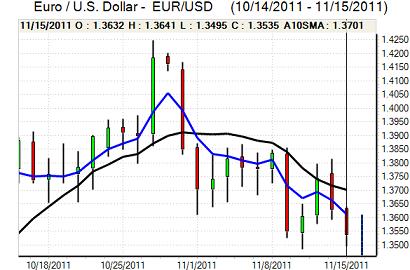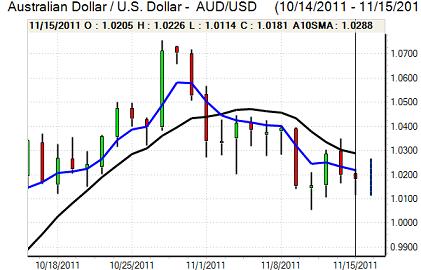EUR/USD
The Euro was subjected to renewed selling pressure on Tuesday. The GDP data was broadly in line with expectations with a 0.2% expansion for the Euro area as a whole as France and Germany managed a solid expansion. There were no data releases for Italy which maintained fears over the underlying outlook. The German ZEW business confidence index weakened to -55.2 for November from -48.3 previously.
There were further important political stresses as Monti encountered further difficulties in forming a new Italian government. The New Democracy Party in Greece also continued to insist that there would be no written commitment to austerity measures which put the government on course for a collision with the EU.
There were further stresses within the banking sector and there was a renewed widening of yield spreads. Italian benchmark yields moved back to the 7% level while Spanish yields also rose towards the 6.50% level. There was also a widening of yields for French and Austrian yields as the contagion effect intensified.
The US growth-related data was slightly stronger than expected with a headline retail sales increase of 0.5% and there was a core 0.6% increase for the month which maintained a slightly more encouraging outlook for spending and the economy as a whole. There was also a recovery in the New York manufacturing sector to 0.6 from -8.5 the previous month, although there was a deterioration in the orders component.
The producer prices data was weaker than expected with a headline 0.3% decline for October while core prices were unchanged for the month. Regional Fed President Evans maintained a generally dovish stance in comments on Tuesday and there will be further expectations that the Federal Reserve will consider additional quantitative easing.
The Euro came under further selling pressure following a break of the 1.35 level and dipped to lows below 1.3450 in Asia on Wednesday.

Source: VantagePoint Intermarket Analysis Software
Call now and you will be provided with FREE recent forecasts
that are up to 86% accurate* 800-732-5407
If you would rather have the recent forecasts sent to you, please go here
Yen
The dollar found support below the 77 level against the yen on Tuesday and was generally trapped in very narrow ranges as both currencies gained support on defensive grounds. The yen continued to gain support from a lack of confidence in the global economy, especially as the Euro-zone contagion risk continued to increase with the threat of further capital repatriation.
The Bank of Japan left interest rates on hold in the 0.00-0.10% range and there was no announcement of any further increase in quantitative easing at the meeting.
The prospects for intervention will continue to be a very important short-term influence with Finance Minister Azumi continuing to warn over the potential for additional action.
Sterling
Sterling was unable to make any headway during Tuesday with selling interest above the 1.59 level against the dollar and there were further losses after support in the 1.5880 area was broken.
The latest headline inflation data was slightly weaker than expected with a decline to 5.0% from 5.2% previously, although the core data was slightly higher at 3.4% from 3.3% previously. The Bank of England was again forced to write a letter to the Treasury explaining why the inflation rate was above the 2% target level. Governor King stated that the inflation rate was set to decline sharply in the first half of 2012 as the effect of the 2011 tax increases came out of the calculation.
King also hinted that the bank could consider further quantitative easing if necessary with a principal focus on the risks posed by the Euro-zone crisis.
The latest unemployment data will be watched closely on Wednesday and the inflation report will also be important, although the underlying content may not be markedly different from Tuesday’s inflation letter. The bank’s outlook for the economy will come under close scrutiny and downbeat comments on the banking sector would tend to undermine Sterling as Libor rates continue to move higher.
Sterling dipped to lows near 1.5750 against the dollar, but the UK currency held firm against the Euro.
Swiss franc
The Swiss franc was subjected to further selling pressure on Tuesday as rumours continued to swirl surrounding the minimum Euro level. The Euro was broadly resilient against the Swiss currency, although there as resistance on any move towards the 1.2420 area. The dollar pushed to one-month highs just above 0.92 against the franc as the US currency secured wider support.
The National Bank policies will remain a very important focus in the short term and there will be further speculation that the bank will push the franc weaker, especially as the bank still believes that the currency is substantially over-valued.

Source: VantagePoint Intermarket Analysis Software
Call now and you will be provided with FREE recent forecasts
that are up to 86% accurate* 800-732-5407
If you would rather have the recent forecasts sent to you, please go here
Australian dollar
The Australian dollar initially found support on dips to the 1.0120 area against the US currency on Tuesday, but hit resistance close to 1.02 and was then subjected to renewed selling pressure with declines to below 1.01, the weakest level for over a month.
There was a renewed deterioration in risk appetite which undermined demand for the Australian dollar as fears over the Euro-zone area increased again. The global banking sector is likely to remain an extremely important focus in the short term and contagion fears will pose an important threat to the Australian dollar with high volatility set to continue.



